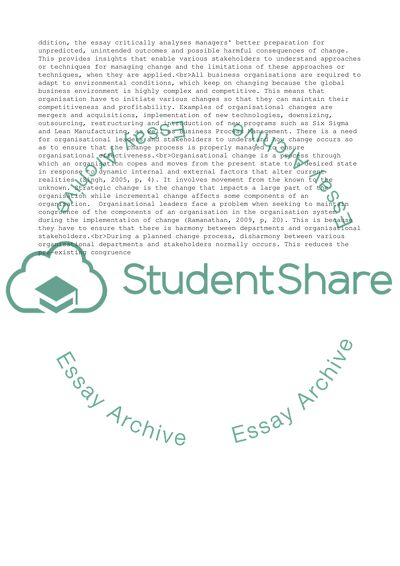Cite this document
(Crisis, Change and Creativity in Organisations Essay Example | Topics and Well Written Essays - 3000 words, n.d.)
Crisis, Change and Creativity in Organisations Essay Example | Topics and Well Written Essays - 3000 words. https://studentshare.org/management/1822789-critically-discuss-the-view-that-planned-change-programmes-may-be-harmful-to-organizations-in-essay-consider-alternatives-to-planned-change-also-draw-on-relevant-scholarly-literature-on-organisational-change-management-continuity-and-creativity
Crisis, Change and Creativity in Organisations Essay Example | Topics and Well Written Essays - 3000 words. https://studentshare.org/management/1822789-critically-discuss-the-view-that-planned-change-programmes-may-be-harmful-to-organizations-in-essay-consider-alternatives-to-planned-change-also-draw-on-relevant-scholarly-literature-on-organisational-change-management-continuity-and-creativity
(Crisis, Change and Creativity in Organisations Essay Example | Topics and Well Written Essays - 3000 Words)
Crisis, Change and Creativity in Organisations Essay Example | Topics and Well Written Essays - 3000 Words. https://studentshare.org/management/1822789-critically-discuss-the-view-that-planned-change-programmes-may-be-harmful-to-organizations-in-essay-consider-alternatives-to-planned-change-also-draw-on-relevant-scholarly-literature-on-organisational-change-management-continuity-and-creativity.
Crisis, Change and Creativity in Organisations Essay Example | Topics and Well Written Essays - 3000 Words. https://studentshare.org/management/1822789-critically-discuss-the-view-that-planned-change-programmes-may-be-harmful-to-organizations-in-essay-consider-alternatives-to-planned-change-also-draw-on-relevant-scholarly-literature-on-organisational-change-management-continuity-and-creativity.
“Crisis, Change and Creativity in Organisations Essay Example | Topics and Well Written Essays - 3000 Words”. https://studentshare.org/management/1822789-critically-discuss-the-view-that-planned-change-programmes-may-be-harmful-to-organizations-in-essay-consider-alternatives-to-planned-change-also-draw-on-relevant-scholarly-literature-on-organisational-change-management-continuity-and-creativity.


